Menus
- 3-cylinder, super single, V4 engine, steam hammer, speed bike and super athlete
- Yamaha SRX 6
- BMW K 75 S.
- Kawasaki GPZ 1000 RX
- Suzuki GSX-R 1100
- Bimota DB1
- Suzuki LS 650
- Suzuki GSX-R 750 Special Edition
- Honda VFR 750 F.
- Yamaha FJ 1200
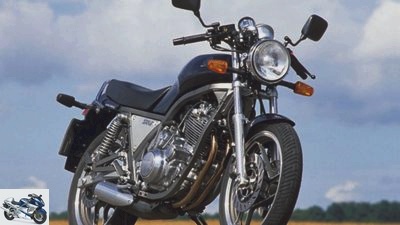
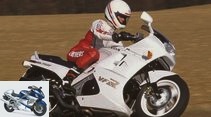
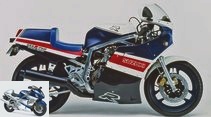
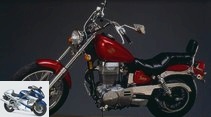
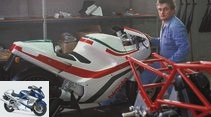
11 photos
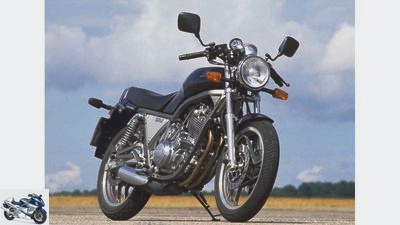
1/11
25 years ago there was a lot going on in the motorcycle industry. The development was more innovative than ever before. The most outstanding new releases are now here. It all starts with the Yamaha SRX 6: Lots of polished aluminum, chrome and stainless steel: the little Yamaha was well made. At that time opinions were divided on the stub exhaust, today many athletes wear it.
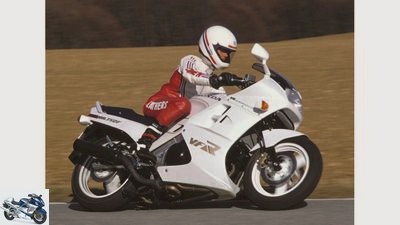
2/11
Honda VFR 750 F: Honda VFR 750 F: Probably the best motorcycle from 1986 and a great machine to this day. It is not for nothing that many manufacturers also use the V4 principle in GP sports. It couldn’t be more balanced.
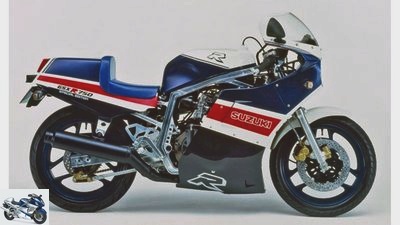
3/11
Suzuki GSX-R 750 Special Edition: Made fit for the racetrack with factory tuning: In addition to the normal GSX-R 750, Suzuki also delivered a Special Edition in 1986. It weighed just under 200 kilograms with a full tank of 100 hp, an absolute record.

4/11
Suzuki LS 650: Long fork, deep seat, lots of chrome and a bit of single-cylinder flame: Suzuki LS 650 as the best Japanese chopper of its time. And to this day actually one of the most beautiful Suzuki.
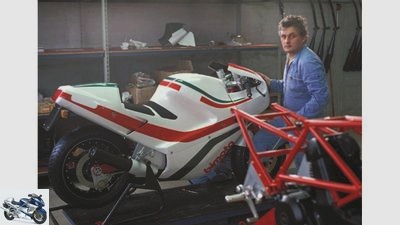
5/11
Anyone who owns a Bimota DB1 today is a happy person. Not only because he can call his own a motorcycle that is now very valuable, but also because he has a piece of contemporary motorcycle history in his garage. For the first time a motorcycle was completely covered, neither the beautiful Ducati-V2 nor the phenomenal tubular frame were allowed to come out into the world.
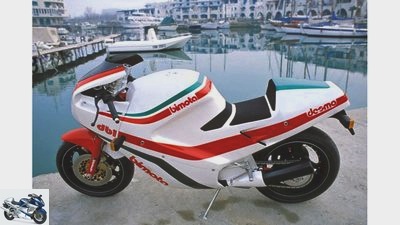
6/11
From Italy the Bimota DB1 – Radically clad: Bimota DB1 with slim plastic casing. Underneath is a 750 Ducati V2 and a beautifully crafted tubular space frame. It’s a shame you can’t see it.
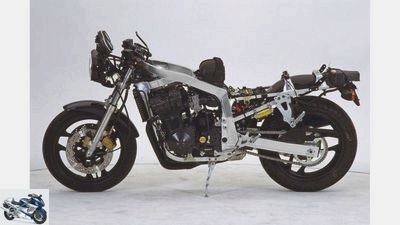
7/11
The Suzuki GSX-R 1100 – this time without disguise: Racing technology at its best: 1986 GSX-R 1100 with aluminum frame, air / oil-cooled engine and beautifully finely ribbed cylinder block. To this day it is actually the most beautiful inline four-cylinder that has ever been built.
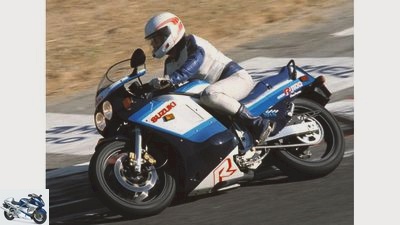
8/11
Suzuki GSX-R 1100: The first super sports car with lots of power and extremely low weight.
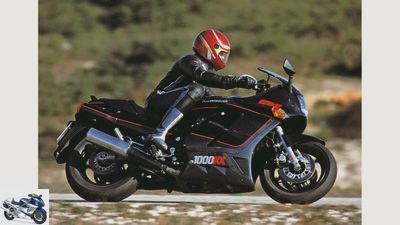
9/11
Kawasaki GPZ 1000 RX: The fat Kawasaki is the forefather of all fat Kawasakis from ZX-10 to ZZ-R 1400. Always with the fastest, but mostly quite comfortable and suitable for travel.
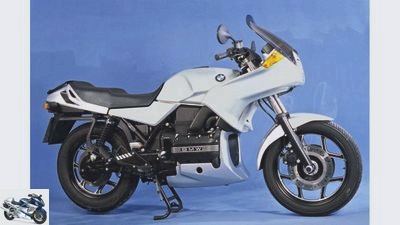
10/11
BMW K 75 S: Almost as big as the K 100: K 75 S with a three-cylinder engine. The half-shell fairing calmed the chassis immensely, and it is characterized by the good touring characteristics and the robust engine.
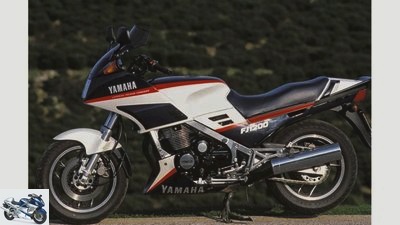
11/11
Yamaha FJ 1200: Beautiful sports tourer with half fairing and air-cooled engine: Yamaha FJ 1200. A machine that stood for the famous brand with the three tuning forks.
Motorcycle development in the mid-1980s
3-cylinder, super single, V4 engine, steam hammer, speed bike and super athlete
Content of
What moved the motorcycle scene 25 years ago? Many new machines that would make history came on the market. MOTORRAD Classic highlights the most important developments a quarter of a century ago.
F.1986 was a mixed year for the world. The old human dream of complete mastery of technology experienced serious setbacks. America lost faith in NASA with the exploding Challenger space shuttle, in Russia a test at the Chernobyl nuclear power plant failed with devastating consequences for the whole world.
For the motorcycle scene, however, a coming boom flashed. The industry was more innovative than it has been in a long time. New engine concepts, new categories and new designs were boldly developed. The Japanese manufacturers in particular worked hard and pushed their machines into completely different performance categories. 125, 130 hp, nothing seemed impossible anymore. At least in Germany, the voluntary power limit to 100 hp still applied.
Some of these machines that were created at that time established series that still exist today. A Suzuki GSX-R 750, a Kawasaki 1000 RX, Honda VFR or even a Yamaha FJ 1200 are still alive today. At that time, the creative power of BMW was rather weak. After all, they brought the three-cylinder K 75 S. Uncompromisingly sporty and stylistically shaping the style, on the other hand, was the Bimota DB1, a pioneering racing replica.
Yamaha SRX 6
It’s hard to believe: In 1985, the readers of MOTORRAD voted this machine by far in first place in the readers’ choice “Motorcycle of the Year”. And when the slim and very elegant machine came onto the market in 1986, the testers were full of praise. Yamaha had given the road single cylinder a new shape.
A pure motorcycle through and through, but very difficult to start thanks to the Kickstarter. The engine came from the Yamaha XT 600 and was only slightly drilled out for use on the road. Anyone who expected a beefy draft was quickly disappointed. The single cylinder laboriously shook its way up the speed ladder to reach just 42 hp to the clutch. At a good 160 km / h it was usually over, maybe too little to inspire the masses. Or maybe the price was simply too high, after all, the slim machine cost 7130 marks. The crowd favorite quickly turned into a wallflower. Too bad. Design and workmanship were great.
BMW K 75 S.
archive
The BMW K 75 S: Almost as big as the K 100: K 75 S with a three-cylinder engine. The half-shell fairing calmed the chassis immensely, and it is characterized by the good touring characteristics and the robust engine.
The naked BMW K 75 was quite a jelly. With a half fairing, BMW cured the suspension unrest lastingly. How badly BMW had gotten wrong constructively with the horizontal engine could be seen from the K 75. For the four-cylinder engines, relatively small 67 mm cylinder bores had to keep the engine as short as possible so that the machine didn’t get too long. The three-cylinder would have had a lot of leeway, which the modular system of the Munich-based company at the time did not allow.
The two-valve triplet hissed just over 70 hp from the triangular exhaust, a Suzuki GSX-R 750 made 100 hp. No chance? But. The engine was almost indestructible, the workmanship of the BMW was very good. That created a loyal fan base.
Kawasaki GPZ 1000 RX
archive
The Kawasaki GPZ 1000 RX: Quite a buffalo: The fat Kawasaki is the forefather of all fat Kawasakis from ZX-10 to ZZ-R 1400. Always with the fastest, but mostly quite comfortable and suitable for travel.
Wow what a hammer! 125 hp, 1000 cm3, 252 km / h top speed measured by the MOTORRAD test people: Kawasaki was right at the front in 1986. And brought the mother of all big speed Kawasakis from the ZX-10, ZZ-R 1100 to today’s ZZ-R 1400 to the road.
The 267-kilo buffalo was even very comfortable to drive. And thanks to the fully protective fairing and large 21-liter tank, even long stages were no problem. It’s a shame that a 16-inch front wheel was often installed during this time. Most of the machines look quite wobbly with it. So the Kawa turned in uncleanly. The hydraulic anti-dive systems on the front forks were also a bad fashion, usually they don’t work properly as they only harden the damper pressure stage and thus slow down but not prevent immersion. No matter: The Kawasaki was a real Kawa – strong, fast and mean.
Suzuki GSX-R 1100
archive
The Suzuki GSX-R 1100: The first super sports car with lots of power at an extremely low weight. Racing technology at its best: 1986 GSX-R 1100 with aluminum frame, air / oil-cooled engine and beautifully finely ribbed cylinder block. To this day it is actually the most beautiful inline four-cylinder that has ever been built.
Wow again! Suzuki showed the world what Hamamatsu can do in 1986. Although it carries a powerful, open 130 hp four-cylinder, it weighs only 225 kilograms with a full tank. Consistent lightweight construction like that of a racing motorcycle was the developer’s motto, and in 1986 Suzuki set standards. It would take a very long time before a super sports car in this displacement category was built with similar lightness again.
But also the look with the slim racing fairing and the double headlights borrowed from endurance racing was awesome. The machine was held together by a rather filigree aluminum frame, which was more closely modeled on a double-loop tubular steel frame. A pretty soft number, a comparison with today’s chassis shows how limp Suzuki designed the chassis back then.
Bimota DB1
archive
The Bimota DB1 from Italy: Radically clad: Bimota DB1 with slim plastic casing. Underneath is a 750 Ducati V2 and a beautifully crafted tubular space frame. It’s a shame you can’t see it.
Anyone who owns a Bimota DB1 today is a happy person. Not only because he can call his own a motorcycle that is now very valuable, but also because he has a piece of contemporary motorcycle history in his garage. For the first time a motorcycle was completely covered, neither the beautiful Ducati-V2 nor the phenomenal tubular frame were allowed to come into the light of day. Everything was hidden under a nicely painted and neatly processed plastic shell.
Also awesome: the 16-inch wheels glued and riveted from two halves. Today the Bimota looks almost tiny, at most a 250cc engine is suspected under the shell. But when the 750 Ducati V2 is started, thunder echoes through the city. The manual precision and love with which the Bimotas were built during this time is unique. Had Bimota continued on this path, the company would not have been close to bankruptcy several times later. Today, in the Italian seaside resort of Rimini, only Ducati bimotas are built. Better this way.
Suzuki LS 650
archive
The Suzuki LS 650: Long fork, deep seat, lots of chrome and a bit of single-cylinder flame: Suzuki LS 650 as the best Japanese chopper of its time. And to this day actually one of the most beautiful Suzuki.
Hard to believe the courage with which Suzuki courted motorcyclists. In addition to the brilliant super sports cars, the brand also brought a lovingly made single-cylinder chopper onto the market. In addition to the large Intruder, which is also turning 25, the small LS was the first real Japan chopper.
With a stroke of 94 millimeters, the single already put quite a bit of torque on the rear wheel. In the case of the Suzuki, two balance shafts take care of eliminating annoying vibrations. Radically low seating position, footrests set far forward, speedometer in the tiny 11-liter tank, that’s what a chopper should look like. In addition, for the first time toothed belt drive. Today the LS is a collector’s item.
Suzuki GSX-R 750 Special Edition
archive
The Suzuki GSX-R 750 Special Edition: Made fit for the racetrack with factory tuning: In addition to the normal GSX-R 750, Suzuki also delivered a Special Edition in 1986. It weighed just under 200 kilograms with a full tank of 100 hp, an absolute record.
This story has to be told again here: In order to properly test the super sporty 750 series, the motorcycle editors named Horst Vieselmann and Axel Westphal at the 1000 kilometer Hockenheim, the now legendary rally event at Easter. The machine passed the endurance test absolutely without complaint and in the sprint test the two professional testers did not let anyone or anything steal their bread: Victory after 1000 kilometers and a top certificate for the new 750.
Suzuki brought the right motorcycle for such operations. Factory tuning: The already ultra-light and strong standard GSX-R has been improved even further with a dry clutch, flat slide carburetors and one-man seat and made really fit for the racetrack. But it wasn’t easy to drive.
Honda VFR 750 F.
archive
The Honda VFR 750 F: Honda VFR 750 F: Probably the best motorcycle from 1986 and a great machine to this day. It is not for nothing that many manufacturers also use the V4 principle in GP sports. It couldn’t be more balanced.
Yes, the Honda VFR existed as early as 1986! And it is still in a similar form at Honda dealers today. And in the Crossrunner, a travel version with plenty of travel, it should even reap new fame. 25 years ago it was a real challenge from Honda. 100 hp V4 engine with four gear-driven, overhead camshafts, who could offer that? In addition an aluminum frame that offered brilliant handling and high driving stability. A dignified athlete, underlined by a subtle paintwork, who still has friends today.
The V4 sounded particularly great with its 180-degree crankshaft. Especially when the immense speed reserves of up to 11,500 rpm have been exhausted. With a top speed of 237 km / h, the Honda was also the fastest 750 of its time. To this day, the VFR is one of the most characterful sports machines from Japan.
Yamaha FJ 1200
archive
The Yamaha FJ 1200: Beautiful sports tourer with half fairing and air-cooled engine: Yamaha FJ 1200. A machine that stood for the famous brand with the three tuning forks.
She was affectionately known as Franz-Josef, the fat Yamaha. With her powerful 1200 series quad, she made many friends straight away. Even the previous model, the FJ 1100, impressed with its great travel qualities. At that time, the Yamaha was the largest four-cylinder machine from Japan. In terms of pulling power and acceleration, Franz-Josef set the standard.
In addition to the super comfortably tuned chassis with relatively long suspension travel, the large 24.5 liter tank was also impressive. In this way, large stages could also be tackled. The soothing murmuring engine did the rest to transport the crew and luggage stress-free.
The beautifully ribbed engine in the Yamaha XJR 1300 is still used today as a drive. There it is almost completely the same and still brings a whopping 106 hp to the clutch.
Related articles
-
Engine concepts from KTM, Triumph, Husqvarna and Kawasaki
Gargolov 25th photos Gargolov 1/25 Husqvarna Nuda 900 R, Triumph Street Triple R, KTM 690 Duke and Kawasaki Z 750 R Black Edition. Bikes with different…
-
Famous motorcycles: Bimota YB4 750 E.I.
archive Famous motorcycles: Bimota YB4 750 E.I. Bimota’s most beautiful Sometimes it is just like this: the first draft is also the best. With Bimota…
-
Langen Motorcycles: Cafe Racer with a 250cc two-stroke engine
Long Motorcycles 15th photos Long Motorcycles 1/15 The British motorcycle manufacturer Langen Motorcycles puts the The 2 stroke a Cafe Racer with a 250cc…
-
Supersport motorcycles in comparison test on the racetrack
Bilski 34 photos Bilski 1/34 Track test super athlete. Bilski 2/34 … The fact that he chose the Suzuki for this high-speed posing speaks for its…
-
Sports tourer concepts in a comparison test
www.factstudio.de 29 photos www.factstudio.de 1/29 Experience German-German history: The heavily secured border with wall and barriers between East and…
-
600 super sports car: Motorcycles tested in 2012 – with suspension settings
Jahn 33 photos Jahn 1/33 2012 super sports cars in comparison: Honda CBR 600 RR, Kawasaki Ninja ZX-6R, MV Agusta F3 675, Suzuki GSX-R 600, Triumph…
-
Concept comparison: inexpensive motorcycles
Concept comparison: Inexpensive motorcycles A. P Attractive and inexpensive, that’s them. The Aprilia Pegaso 650 Garda, the Kawasaki W 650, the Suzuki SV…
-
Concept comparison: motorcycles for 9,000 marks
Concept comparison: motorcycles for 9,000 marks We don’t need millions “Fortunately, we don’t lack a penny …” Honda Vigor 650, Kawasaki ER-5 Twister,…
-
Wellbrock-Honda VFR 750 R with V-four engine
Limited Edition: Wellbrock-Honda VFR 750 R Legendary Honda VFR 750 R RC 30 Contents of The legendary V-Four under this sun is the one who …
-
Comparison test: touring motorcycles
fact 39 photos fact 1/39 But now to the tourer bikes. The entry point is the BMW R 1200 RT, which despite its mediocre engine impresses with its…